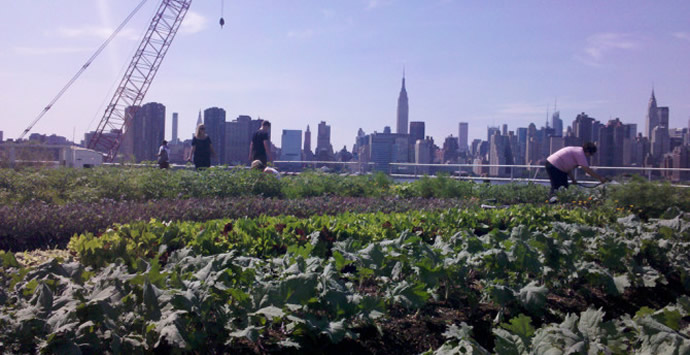Why farm the city?
Agriculture has made cities a reality. Without a reliable food supply, it is simply not possible for large numbers of humans to settle together in the same location, and agriculture has allowed us to do this on a staggering scale. For the first time in our history, more people live in cities than rural areas. More than 1,000 cities worldwide have a population of one million or more. So with all of this success, why change the status quo?

Eagle Street Rooftop Farm, Brooklyn. Image courtesy of Harvard University
In a rapidly urbanizing world, we are faced with a very real challenge — supporting a larger population with fewer resources. The United Nations predicts that by 2050 the global population will reach nine billion, with over six billion people living in urban areas. This is uncharted territory for our civilization, and could require an increase in food production by as much as 70 percent.
Our current food system is already showing the strain. Disconnecting the farm from the city has enabled food production at an industrial scale but is reliant on significant infrastructure to process food and transport it to the city’s hungry mouths. It is here that many issues and questions arise.
- Health: Food items are often produced for maximum shelf-life and transportability, not nutrition. Worldwide, 1.6 billion people are now overweight, with significant medical and financial implications. Could short food chains with more localized food production make people healthier?
- Waste: Globally over one-third of all produce is spoiled before reaching the consumer. What would it mean to future food requirements if this number could be reduced significantly? What if the food that did still spoil could be fed directly into a city’s nutrient cycle?
- Oil: Industrial food production is reliant on fossil fuels at all stages of the process, from fertilizer and pesticide, to farm machinery operations, to transportation. What happens when the oil runs out?
- Energy: In the U.S. food system, an individual’s daily share of energy consumption is eight times the minimum required to support a healthy diet. As energy costs increase, how will this affect what we eat and how we grow it? Could urban farms harness waste energy from surrounding buildings?
- Water: Both water shortages and flooding are symptoms of climate change that threaten food security. Population growth will exacerbate this threat. What if food production used 90 percent less water and was shielded from climatic extremes by the urban fabric, using techniques like aquaponics?
- Community: Many urbanites have become so divorced from the food system that a child may grow up on a diet of French fries but have no idea what a potato looks like. What if the process was once more made visible, becoming a focus for education and community building?
Just at the point when we become a civilization of urbanites, the food foundation on which cities rely is faltering. This can be seen as a time of great opportunity. While it is easy to view the city as a thing in stasis, the reality is quite different — adapting to market demands and external pressures. The way that cars changed cities in the middle of the twentieth century illustrates this well. Now the great car city of Detroit, already home to some of the largest urban farms, is illustrating a new and potentially equally transformative trend. Farming the city is no longer a hobby for the few but an answer to some very real global challenges.






